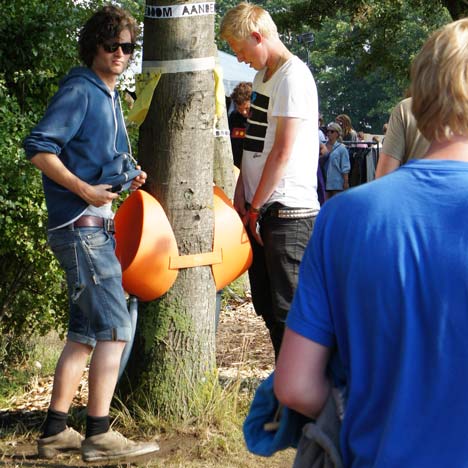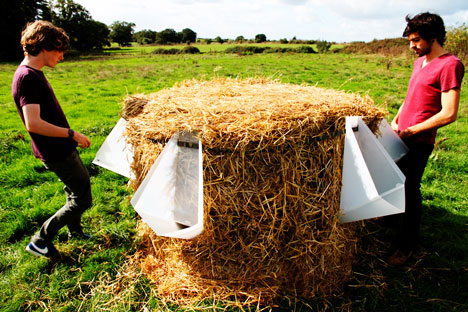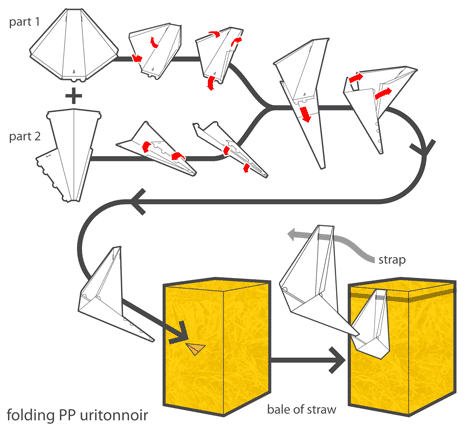Back in 2010, The P-Tree by Dutch designers Aandeboom turned up on inhabitat as a prototype. In 2011, unable to prevent revelers urinating against their trees, the Roskilde Festival in Denmark installed the tree-mounted urinals. The P-Tree is ingenious in taking pressure off porta-potties at public events, but suffers from still having to be connected up to either the main sewer or to a local treatment installation.
We didn't have to wait long for the next logical development. An outrageously simple outdoor urinal by French design studio Faltazi slots into a straw bale to recycle pee from festival goers into compost. L'Uritonnoir is a cross between a urinal ("urinoir" in French) and a funnel ("entonnoir"), and comes in two versions – the flat-pack polypropylene DIY model and the stainless steel Deluxe model.
To set up a urinal, L'Uritonnoir is pushed into the side of a straw bale and fixed in a place by looping a strap through its top holes. As the bale collects liquid, nitrogen from urine combines with carbon in the straw and starts a process of decomposition. After use, the bale can either be taken to a local composting facility or left on the spot for six to 12 months to become compost, before being scattered on the soil or used as a planter.
I like it.
See the manufacturer's site here.
Or a very good set of images and full description on Dezeen here.
Dezeen also has the best coverage of the P-Tree here.
We didn't have to wait long for the next logical development. An outrageously simple outdoor urinal by French design studio Faltazi slots into a straw bale to recycle pee from festival goers into compost. L'Uritonnoir is a cross between a urinal ("urinoir" in French) and a funnel ("entonnoir"), and comes in two versions – the flat-pack polypropylene DIY model and the stainless steel Deluxe model.
To set up a urinal, L'Uritonnoir is pushed into the side of a straw bale and fixed in a place by looping a strap through its top holes. As the bale collects liquid, nitrogen from urine combines with carbon in the straw and starts a process of decomposition. After use, the bale can either be taken to a local composting facility or left on the spot for six to 12 months to become compost, before being scattered on the soil or used as a planter.
I like it.
See the manufacturer's site here.
Or a very good set of images and full description on Dezeen here.
Dezeen also has the best coverage of the P-Tree here.



5 comments:
The P-Tree and Pollee do indeed open up further exploration into portable toilet design and composting solutions, fitting in well with public events and festivals.
Agreed too, is whether the P-tree solution will take off as more "permanent" solutions in public parks and spaces of cities. One is the odour, and not forgetting hygiene issues due to splashing and often poor aiming (requiring constant cleaning/upkeep by cleaners), and whether modesty issues of of using such urinals will become socially and culturally acceptable in more westernised/industrialised societies like Australia and Singapore.
Female urinals... now that's one big debate I've had with several ladies, including with my own sister! While commercial-use female urinals (resembling a bidet) do exist, they haven't seem to catch on in the mainstream. My sister has said that she herself will never use one, or believes that a female urinal can never be designed adequately, due to hygiene and modesty concerns - especially with skirt wearers in the big city (a prevailing cultural issue). Another lady friend of mine says that women... well, they can't pee the way men do, due to anatomical differences.
Which makes the pollee, while very well suited for one-off festivals and outdoor public events, actually even more difficult to catch on as more more "permanent" sanitation solutions in westernised cities and countries.
(I've used composting toilets during my 5-months of living in the Australian bush countryside, but I still shudder a little at the memories of the odour; putting in mulch and sawdust after each use, and my perceived hygiene problems!)
Both P-Tree and L’Uritonoir catch my attention the moment I saw them. I would say that they’re innovative and unique, not because of the shape, but it’s their strategy to deal with the certain issue intended. For example, P-tree was invented, in order to prevent revelers urinating against their tree(1)
Similarly, Pollee is another public urinal designed for women by Copenhagen Studio UiWE (2). However, my main concern with these devices has something to do with the hygiene factor(3). Remembering that urine smells, these urinals might not be the most advantageous strategy, as they’re exposed to the open-air environment. In addition, urine odor may create minor problem to certain people such as headache. Therefore, if these devices are to be implemented in cities, good and proper sanitation needs to be taken into account (3).
On the positive side, I do believe that the cost of constructing P-Tree is definitely going to be cheaper than constructing proper public toilet. Instead of using massive materials such as concrete and steel, which Kumutoto Toilets require(4), the materials needed to construct P-tree are fairly cheap and simple. They’re rotational molding recycled plastic, straps and lashings(5)
I think P-tree might be suitable for cities in European countries. However, some laws and regulations in certain countries still prohibit public urination(6). In the city where I come from (Jakarta, Indonesia), I think P-Tree would not be the most beneficial idea. Not only because of the eastern cultural customs which consider public urination to be something unusual, but if these devices are installed publicly in a city of more than 10 million people, they can be a source of vandalism.
1. http://inhabitat.com/p-tree-urinal-a-natural-solution-to-an-urgent-problem/
2. http://www.dezeen.com/2011/07/15/pollee-by-uiwe/
3. http://voices.yahoo.com/the-real-hygiene-care-health-risks-bacteria-388796.html
4.http://www.dezeen.com/2012/08/10/kumutoto-toilets-by-studio-pacific-architecture/
5. http://aandeboom.nl/P-Tree
6. http://www.bbc.co.uk/news/magazine-18072905
Kevin,
I think both P-Tree and L’Uritonoir are really intended only for places where a water-borne connection is impractical, and typically only for major outdoor events like festivals.
BTW. Both do help to improve life for women, because they take load off the enclosed portable toilets provided at these events. That said, any developments in helping acceptance of female urinals can only help....I have seen young women at conventional building venues get so upset with the queues for female toilets, that they have invaded the men's, and using the urinals in spite of the fact they are not appropriately designed.
I agree that this concept is a great idea for festivals. I also like its ability to raise awareness of waste management and recycling, in particular how such a readily source may be transformed into other forms of energy. It is also interesting to consider on how the L'Uritonnoir may be adapted to make use of locally sourced material in here in Australia.
The L'Uritonnoir has two main sections that correlate to the basic rules of compost making. For successful and fast decomposition a correct balance of nitrogen and carbon bust be obtained. In this example straw has been used which makes up the carbon section. Is it likely that this material may be substituted for bulky organic material sourced from local bush/park land? Many Australian native plants produce copious amounts of organic matter or mulch that contains very high levels of carbon.
Through this use of carbon and nitrogenous materials I do believe that Faltazi have begun to overcome the issue of smell. Indeed a compost pile has the potential to produce large amounts of ammonia. This only occurs when the nitrogen to carbon ratio gets out of hand. To prevent this from happening monitoring would be needed to assess the amount of urine entering the system.
Mixing up the carbon and nitrogenous materials as well as providing adequate access to air can significantly improve decomposition. In turn these actions would also help prevent smell. This would mainly be an issue if the L'Uritonnoir were to be kept in its original location within a public park after festival events.
I presume Faltazi would have made an effort to use sustainable material for the funnel section of the L'Uritonnoir. I’ve noted that they have chosen to use plastic and metal, which could be used over and over again. Seeing as though this concept is best suited to short life spans, I’m sure cardboard could be substituted and then thrown into the decomposing pile afterwards, avoiding any needs of cleaning.
The open nature of the design and lack of privacy also have few pros and cons. I’m sure many punters would not feel comfortable at the likelihood of unintentionally observing another urinate. At the same time this lack of privacy may help in controlling the illegal smuggling of drugs into festivals. Privacy is often preferred or necessary when recovering strategically hidden illegal substances from awkward places.
All in all I consider this concept to have great potential and look forward to finding similar design being utilised here in Australia. I have notice in recent months that the Sydney City Council has been running trials of a similar concept that responds to a different issue regarding partygoers inappropriately urinating on the streets. (1) I’m expecting to see positive results. I’d also like to see this design be incorporated into the contemporary household. Recycling urine as nitrogenous fertiliser in the garden and at the same time reducing water usage, why has this idea not already become commonplace??
1 - http://www.smh.com.au/national/mind-your-pees-and-queues-novel-solution-for-bladders-behaving-badly-20110406-1d4kn.html
I used to urinate on the lemon tree, like good old guys of my father's generation....The lemon tree died first, but not because i killed it. Before it did, it had great lemons.
Post a Comment